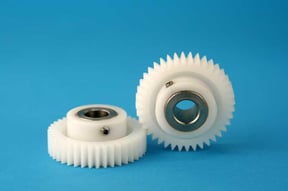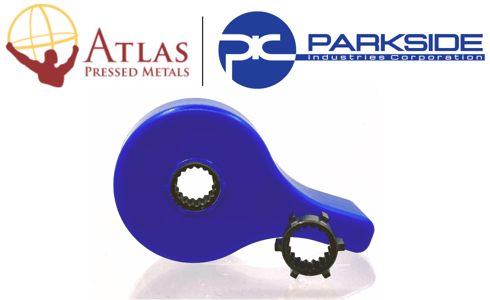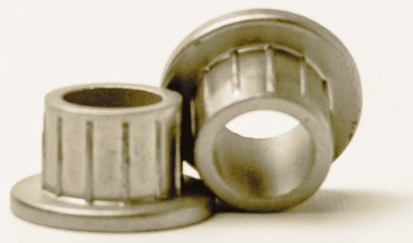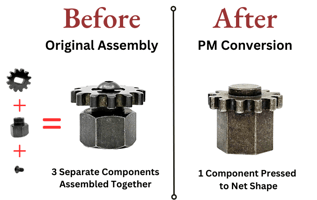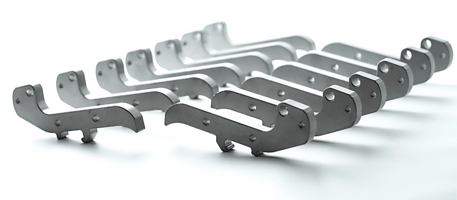Powder Metal Conversion Results in Significant Cost Reduction with Design Optimization. Let Us Help...
Using PM for Plastic & Metal Component Assemblies: A Powerhouse Duo
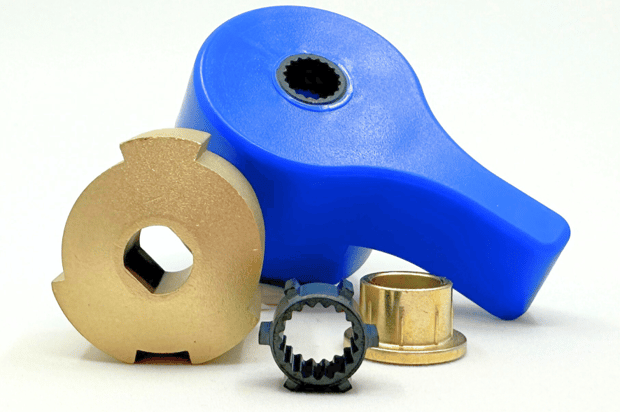
Plastic molding manufacturers frequently use metal forming applications like stamping, machining, and cold heading for in-mold assemblies, not realizing the potential of powder metallurgy (PM). If you’re looking to create a customized, structural part for your plastic and metal component assembly, PM may be a great solution.
You may be asking:
- Will powder metal components support industrial lightweighting demands?
- What are the advantages of powder metal over competing applications?
- How do I know if PM is a good option for my assembly?
- What are some examples of PM parts used in plastic and metal component assemblies?
- How can I improve my assembly with a powder metal conversion?
These are the questions you should ask with any potential process change.
Will Powder Metal Components Support Industrial Lightweighting Demands?
In-mold assembly designs using powder metallurgy parts are becoming more common. Sintered metallurgy’s rise to popularity is attributed to diverse sectors looking for manufacturing applications that can support industrial lightweighting demands.
Compared to other metal components made from wrought or cast materials, powder metal is 10-15% lighter. So, if you are looking to reduce weight without sacrificing structural strength, powder metal is a great option.
With a diverse range of powder blend mixes and additives, sintered metal allows for the creation of a wide array of highly customized, structural components. Once complete, you can seamlessly integrate powder metal parts into final assemblies. Whether plastic overmolded or metal insert molded, completed applications manufactured with plastic and powder metal are strong, durable, and light.
What Are the Advantages of Powder Metal Over Competing Applications?
The powder metallurgy process, compared with other metal forming applications, provides a host of other advantages for metal insert molding or plastic overmolding.
The top 5 benefits are:
- The powder metallurgy process offers part-to-part uniformity for improved product quality – from the first part to the last, your component will always be the same.
- Custom tooling and extensive powder options give you shape and material flexibility to optimize designs for complex applications.
- With a vast range of application versatility, powder metal components are viable in almost every industry.
- Lower energy consumption, higher material utilization, increased production speeds, and limited secondary operation requirements make powder metal a cost-effective solution.
- In comparison to traditional insert materials, powder metallurgy offers improved compressive limits, which directly impacts part cost and performance.
How Do I Know if PM Is a Good Option for My Assembly?
To get the best results when using mixed materials for plastic and metal component assemblies, get familiar with the fundamentals of powder metallurgy.
It’s also imperative to work with your powder metallurgy supplier to determine the requirements of the mating materials and the application. For plastic overmolding or metal insert mold assemblies, consider:
- What temperature will the PM part be subject to during the in-mold assembly process?
- What are some design considerations for using powder metal in plastic and metal component assemblies?
- What are the application’s load requirements, and have you identified wear points?
Temperature Considerations
Sintered metal components by nature are porous. Bearings are usually impregnated with oil to improve the durability of the part and to provide additional corrosion protection. Structural components may also be oiled, plated or impregnated for corrosion protection.
Knowing the temperature of the application is important for assuring that the flash point of any of these operations is appropriate for the assembly process. Verify that the temperature does not impact the chosen material or component dimension.
Assembly Design Considerations
Plastic Overmolding Application
During the plastic overmolding process, achieving a strong bond between the plastic and metal requires clean, oil-free parts.
But wait – didn’t we just say parts are oiled for durability and anti-corrosion?
If an overmolding assembly application has a sintered metal part that’s exposed, then the manufacturer can add the oil after the assembly process.
Metal Insert Mold Application
For metal insert mold applications, you’ll need to evaluate options for preventing push-out or slippage. Sintered metal components can engage with plastic by adding part design features like a:
- Simple metal spline
- Straight knurl
- Flange
Diamond knurl or recessed rings can also be machined into the part as a secondary operation to aid the push-out force.
Load & Wear Considerations
Whether creating an overmold or insert mold assembly application, powder metal components can bond with plastic to provide:
- Structure
- Support
- Durability
PM can provide the extra material strength to increase the performance of mounting points. PM has a high compressive yield strength, making it more robust than competing forming technologies like stamping or cold headings. Finally, PM can also improve and provide required wear characteristics for the application.
Examples of PM Parts in Plastic & Metal Assemblies
Example 1: Valve Handle Application
Project Summary: Atlas Pressed Metals, Parkside Industries Corporation, and the end customer worked together to design a custom powder metal component for a plastic overmolding assembly. Based on the requirements of the application, an iron-based material with a steam treatment finish was selected.
Throughout the development phase, the team worked on refining the spline detail of the inside diameter to ensure that it aligned with the mating part of the application. Now in full production, Atlas manufactures this PM part and ships it to Parkside Industries for the plastic overmolding application.
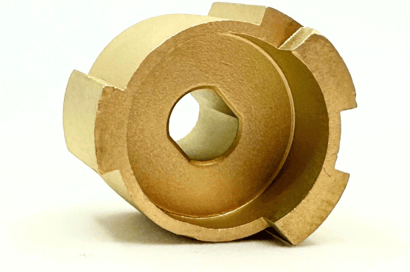 Example 2: Decorative Handle Application
Example 2: Decorative Handle Application
Project Summary: This component goes into a plastic overmold assembly for a decorative handle application. The advantages of using PM for this application are:
- Minimized machining
- Lighter weight
- Corrosion-resistant
- Spark-resistant
- Great dimensional control
Example 3: Automotive Application:
Project Summary: This component joins forces with a plastic assembly. Originally designed to be stamped and rolled, Atlas was able to help their customer to convert their design. By converting to PM, the customer improved cost, created a stable holding system, and enhanced compressive resistance.
Does Your Metal Part Have Powder Conversion Potential?
If you’re using a non-powder metal component for your in-mold assembly, you may want to consider a conversion.
Converting your part from a forming process like stamping, casting, machining, or cold forming to powder metal can result in significant cost reductions, increased part consistency, and decreased production time. While not every part is a candidate for a conversion, a powder metallurgy expert will be able to conduct a part review of materials, geometry, assembly, and application requirements.
To learn more, check out Atlas’ three-part conversion series:

